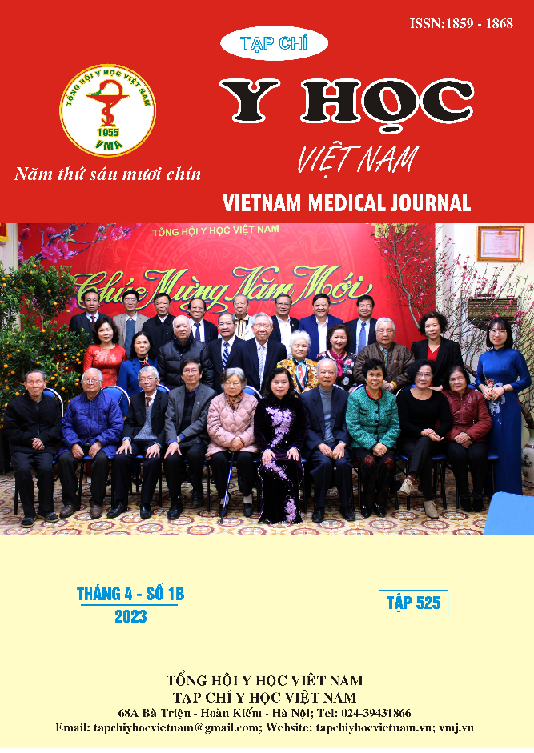EPIDEMIOLOGICAL, CLINICAL, AND SUBCLINICAL CHARACTERISTICS IN PEDIATRIC PATIENTS BITTEN BY SNAKES AT TIEN GIANG PROVINCIAL GENERAL HOSPITAL
Main Article Content
Abstract
Objectives: To describe pediatric snakebite patients' epidemiological, clinical, and subclinical characteristics at Tien Giang Provincial General Hospital. Methods: The method describes a series of cases with analysis of 60 children who were bitten by snakes hospitalized at the Pediatrics Department of Tien Giang General Hospital from January 1, 2016, to December 31, 2020. Results: Epidemiological characteristics: The age group most bitten was 6-10 years old (41.7%), primarily male (55%), mainly from May to December (76.7%), usually between 16:00 and 20:00 (58.3%). Accidents occurred in and around the home (65%), and most bites were on the feet (56.7%). 100% of children were hospitalized 24 hours after being bitten by a snake, but 46.7% of children did not receive first aid before entering the hospital. Clinical and subclinical characteristics: About 80% of cases have local symptoms: local pain 76.7%, swelling 63.3%, blister 15%, and necrosis 8.3%. Systemic symptoms: hemorrhage 30% (bite bleeding, skin hemorrhage, bleeding gums), vomiting 11.7%, weakness 3.3%. There were 21.7% moderate or higher poisoning, of which 6.7% were severely poisoned. Coagulation dysfunction was the most common manifestation (30%), prolonged PT (28.3%), prolonged aPTT (20%), and platelet reduction <150´103/mm3 (6.7%). Conclusion: The treatment of the patient's relatives, such as garrot, injection, incision, sucking venom, and applying herbal medicine to the snakebite site, affects the delay in transferring to the hospital, affects the life, and leaves a legacy of Evidence for pediatric patients.
Article Details
Keywords
snakebite, antivenom serum, viper.
References
2. Bộ Y tế (2017) Hướng dẫn chẩn đoán và xử trí ngộ độc, Nhà xuất bản Y học, Hà Nội, tr.89-124.
3. Trình Đình Điệp, Bùi Quốc Thắng (2012) "Đặc điểm bệnh lý rắn chàm quạp cắn ở bệnh nhi nhập viện khoa cấp cứu BVNĐ 1 từ năm 2005 đến 2010". Tạp chí Y học TP. Hồ Chí Minh, 16 (2), tr.44-50.
4. Lê Thị Thùy Linh (2016) "Tình hình sử dụng huyết thanh kháng nọc rắn tại Bệnh viện Nhi Đồng 2 từ năm 2010 đến 2014". Tạp chí Y học TP. Hồ Chí Minh, 20 (4), tr.79-86.
5. Ngô Đức Ngọc (2018) Chẩn đoán và xử trí rắn độc cắn. IN Ngô Quý Châu (Ed.) Bệnh học Nội khoa. Nhà xuất bản Y học, Hà Nội, tr.586-597.
6. Bùi Quốc Thắng (2016) Rắn cắn. IN Khanh, N. C., Trà, L. N., Nhạn, N. T., Kim, H. T. (Eds.) Sách giáo khoa Nhi khoa. Nhà xuất bản Y học, tr.416-429.
7. Mã Tú Thanh, Phạm Văn Quang (2017) "Đặc điểm dịch tễ, lâm sàng, cận lâm sàng ở bệnh nhi bị rắn lục tre cắn tại Bệnh viện Nhi Đồng 1 ". Tạp chí Y học TP. Hồ Chí Minh, 21 (4), tr.252-259.
8. Trần Quang Thành, Nguyễn Thị Ngọc Mai, Vũ Ngọc Lương (2019) Tài liệu cấp cứu và điều trị rắn cắn. Lớp tập huấn sơ cấp rắn độc cắn. Trung tâm dịch vụ tư vấn KHCN Y Dược Cần Thơ.
9. Soumyadeep Bhaumik, Soushieta Jagadesh, Zohra Lassi (2018) "Quality of WHO guidelines on snakebite: the neglect continues". BMJ global health, 3 (2), e000783-e000783.
10. R. Ralph, S. K. Sharma, M. A. Faiz, I. Ribeiro, S. Rijal, F. Chappuis, et al. (2019) "The timing is right to end snakebite deaths in South Asia". BMJ, 364, k5317.


